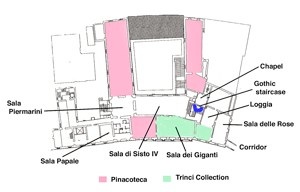
Palazzo Trinci was a princely palace: the rooms on the piano nobile were mainly for public use and their decoration was a public act. Ugolino III Trinci therefore commissioned a series of frescoes for them that depicted secular subjects chosen to reinforce the status of the Trinci rulers. These are among the most important surviving works of this kind in Italy.
The attribution of these frescoes was unclear until 2000, when a book of handwritten notes was found in a private archive in Foligno in which it seems that the scholar Lodovico Coltellini had documented some of the frescoes of Palazzo Trinci in 1780. In particular, he had apparently seen two receipts in a chest in the “camera delle udienze” of the papal governor for payments that Ugolino III Trinci had made in August 1411 and in January 1412 to Gentile da Fabriano for work on three rooms on the piano nobile of the palace. This suggested that Ugolino III Trinci had been commissioned the frescoes soon after the palace was completed: an inscription gives the construction period as 1389-1407, although other documents suggest that the work actually continued until 1411.
The status of the material attributed to Lodovico Coltellini is equivocal, and some scholars doubt that Gentile da Fabriano was associated with the work. However, Ugolino Trinci had family ties with Chiavello Chiavelli, the ruler of Fabriano, and this could well explain such a commission. Many scholars reject the attribution on stylistic grounds, arguing that, if Gentile da Fabriano were indeed involved, the frescoes must have been largely executed by his workshop. The first of the newly-discovered documents included the names of some of his collaborators:
-
✴Jacobo da Venezia, possibly the young Jacopo Bellini;
-
✴Francesco di Giambono da Bologna, who was described as resident in Foligno;
-
✴Battista di Domenico da Padova, who was documented again in Foligno in 1417 and 1426; and
-
✴Paolo Nocchi, the only locally-born artist mentioned.
It seems likely that other artists were also involved in the project.
The three rooms mentioned in the documents were:
-
✴the loggia;
-
✴the Sala delle Rose (also called the Sala delle Stelle or delle Arti e dei Pianeti); and
-
✴the Sala dei Giganti (also called the Sala degli Imperatori).
Most of the frescoes that were discovered under plaster in 1918-9 corridor from Palazzo Trinci to the Duomo are also usually attributed to this group of artists.
Loggia
This space at the top of the Gothic staircase, which formed the entrance to the public part of the palace, was first documented in 1405:
-
✴The entrance behind and to the left (with the Gothic staircase also behind you) leads to the chapel.
-
✴The entrance ahead leads to the Sala delle Rose (see below).
Relief of Hermes and the goat (ca. 250 AD)
This relief is in a niche above the door to the Sala delle Rose. The goat represents the goat-nymph Amaltheia, upon whom Hermes fathered Pan. The relief was among an extensive collection of Roman artefacts that was assembled by Ugolino III Trinci.
Frescoes of the birth of Rome (ca. 1411)
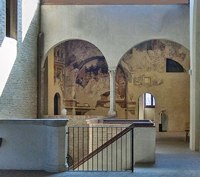
As mentioned above, these frescoes seem to have been the work of Gentile da Fabriano and his workshop. Some of them survive only as sinopie. They depict:
-

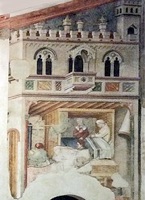
-
✴on the left wall:
-
•Vestals in the temple and (to the right) Mars seducing the nymph Rea Silvia; and
-
•Rea Silva giving birth to Romulus and Remus;
-
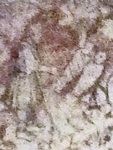
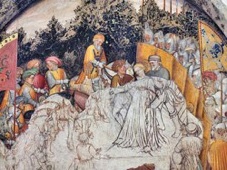
-
✴on the back wall:
-
•the shepherd Faustolo finds the twins being suckled by a wolf and takes them to his wife (upper left, badly damaged); and
-
•the usurper, Amulio executes Rea Silvia and besieges Albalonga, the birthplace of the twins (lower left);
-
✴on the right wall (almost completely ruined):
-
•Romulus and Remus depose Amulio to secure their inheritance; and
-
•they found the city of Rome.
Sala delle Rose
This room is reached from the loggia.
Frescoes of the liberal arts and the planets (ca. 1411)
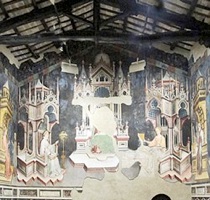
As mentioned above, these frescoes seem to have been the work of Gentile da Fabriano and his workshop. They were rediscovered under plaster in 1918. The subject of the frescoes led to the later name for this room, the Sala delle Arti e dei Pianeti. The humanist Francesco da Fiano devised the associated epigrams and inscriptions for the cycle.
-
✴The liberal arts, each of which is depicted by an allegorical female figure:
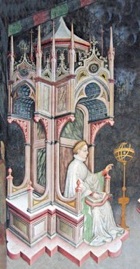
-
•grammar;
-
•dialectics;
-
•music;
-
•geometry;
-
•philosophy (depicted as Queen of the Arts);
-
•astronomy (illustrated here);
-
•arithmetic; and
-
•rhetoric.
-
✴The seven planets:
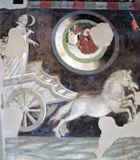
-
•the moon, which is represented as a white figure driving a white chariot (illustrated here);
-
•Mars;
-
•Mercury;
-
•Jupiter;
-
•Venus;
-
•Saturn; and
-
•the sun, which is analogous to the figure representing the moon, but is in red.
-
Each planet corresponds to one of the seven ages of man, which is depicted in a tondo above.
Turn right to walk through the room and take a short detour along the corridor on the left that led to the Palazzo dei Canonici.
Corridor to the Duomo
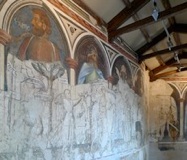
Ugolino III Trinci probably built this corridor in ca. 1407 to provide a covered passage from the palace to the Duomo, and thence to his other residence in the Palazzo dei Canonici (see Walk I). The frescoes in this corridor were discovered under plaster in 1918-9.
Seven ages of man (ca. 1407)
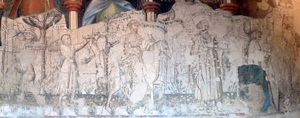
The remnants of this cycle of nearly-monochrome frescoes were discovered beneath the later frescoes (see below) on the left wall of the corridor. Since the corridor was built in ca. 1407 and the later frescoes were executed by Gentile da Fabriano and his workshop in 1411-12, and since the subject of the over-painted frescoes was repeated on the opposite wall in the later frescoes, it is clear that the initial plans were modified in favour of a more ambitious programme at an early stage.
This consideration led Francesco Federico Mancini (referenced below) to suggest that Paolo Nocchi, the only local artist to work under Gentile da Fabriano, might have been commissioned initially in his own right to decorate the corridor and then continued in a subordinate role under Gentile da Fabriano when more ambitious plans were put into effect. This is despite the fact that the earlier frescoes have traditionally been attributed on stylistic grounds to Giovanni di Corraduccio Mazzaforte.
Heroes from antiquity and seven ages of man (ca. 1411)
Although the corridor is not explicitly mentioned in the documents mentioned above, the later frescoes in it are usually attributed to Gentile da Fabriano and his workshop.
-
✴The frescoes on the left depict 11 heroes from antiquity;
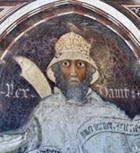
-
•Romulus;
-
•Publius Scipio Africanus;
-
•Joshua;
-
•David (illustrated here);
-
•Judas Maccabaeus;
-
•Hector (lost);
-
•Julius Caesar;
-
•Alexander the Great;
-
•King Arthur;
-
•Charlemagne (lost); and
-
•Godfrey of Bouillon (a hero of the First Crusade - also lost).
-
✴The frescoes on the right depict the seven ages of man, including this depiction of decrepitude.
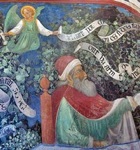
-
✴The figure above the door at the end of the corridor is probably Francesco da Fiano, who devised the cycle.
Return to the Sala delle Rose and take the exit opposite, which leads through the room containing part of the Trinci collection to the Sala dei Giganti.
Sala dei Giganti
This room, which is also known as the Sala degli Imperatori, was the main public room of the palace, running along its façade in what is now Piazza della Repubblica. Like the previous room, this room also contains part of the Trinci Collection.
Frescoes of famous men (ca. 1411)
As mentioned above, these frescoes seem to have been the work of Gentile da Fabriano and his workshop. The frescoes, in which a series of Roman heroes each occupies a portico in a meadow, were discovered under the plaster in 1864. The subjects are taken from Petrarch’s “Lives of Famous Men” (ca. 1367). Francesco da Carrara, Lord of Padua had encouraged Petrarch to complete this book and had also commissioned a fresco cycle (now lost) based on it for his palace. Francesco da Fiano probably devised this broadly contemporary cycle and composed the associated epigrams.
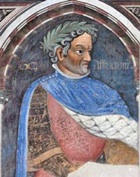
-
✴the Emperor Augustus;
-
✴the Emperor Tiberius;
-
✴Marcus Furius Camillus (who began the Roman suppression of the Etruscans);
-
✴Gaius Fabricius Luscinus (a Roman commander and statesman famed for his incorruptibility);
-
✴Marcus Curius Dentatus (who conquered the Sabines);
-
✴Titus Manlius Torquatus (who conquered Sardinia);
-
✴Lucius Quinctius Cincinnatus (the defender of Rome from the Aequi in the 5th century BC);
-
✴Marcus Marcellus (who captured Syracuse);
-
✴Publius Scipio Africanus (who defeated Carthage, illustrated here);
-
✴Marcus Cassius Sceva (a centurion under Julius Caesar who died heroically in battle);
-
✴Marcus Porcius Cato (Cato the Younger, noble opponent of Julius Caesar);
-
✴Caius Marius (the great Roman general);
-
✴Publius Decius (a grandfather, father and son of this name each died for Rome);
-
✴Gaius Claudius Nero (who defeated and killed Hasdrubal, Hannibal’s brother in law at the Battle of Metaurus); and
-
✴Fabius Maximus (who harried the Carthagians after the Battle of Trasimeno).
The last three figures of the cycle (the Emperor Caligula; Cnaeus Magnus Pompeius, the rival of Julius Caesar; and the Emperor Trajan) are lost.
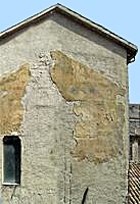
Continue ahead across the stair well and into the Sala Papale.
Sala Papale
This room was also probably redecorated for the visit of Pope Paul III.
Frescoed frieze (ca. 1545)
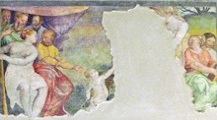
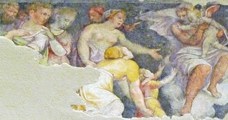
This frieze came to light during recent renovations. It seems the depict allegories of sacred and profane love, although the precise meaning and source for the narrative cannot be determined, not least because much of the work has been lost. The frescoes are attributed on stylistic grounds to Dono Doni, who worked under Lattanzio Pagani (see below) on the almost contemporary frescoes (now lost) for the Rocca Paolina of Perugia.
Return to the Sala dei Giganti and turn left into the Sala di Sisto IV.
Sala di Sisto IV
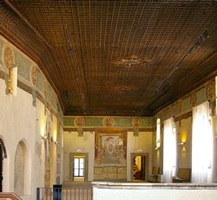
This room, which was originally an open terrace overlooking the inner courtyard, was enclosed in a restoration that followed an earthquake in 1477. Francesco di Bartolomeo da Pietrasanta was appointed as director of works: Pope Sixtus IV probably sent him from Rome to carry out the work, and he subsequently settled in Foligno. The sculpted arms at the centre of the ceiling belonged to:
-
✴Pope Sixtus IV; and
-
✴Cardinal Giovanni Battista Savelli, who was papal legate in 1480-2.
The document of 1477 records that Francesco da Pietrasanta commissioned frescoes of coats of arms, presumably for this room, from Ugolino di Gisberto and Polidoro di Bartolomeo di Tommaso. These no longer survive.
Coats of arms (ca. 1546)
The surviving frescoes on the walls of this room depict the arms of four of the papal legates to Perugia under Pope Paul III:
-
✴Ippolito de’ Medici (1529-35, north wall);
-
✴Marino Grimani (1535-9, west wall);
-
✴Ascanio Parisani (1542-5, south wall); and
-
✴Tiberio Crispo (1545-8, south wall).
These frescoes were probably commissioned for the visit of Paul III in 1546. The scholar Durante Dorio, who lived in the latter part of the 16th century, attributed the arms of Tiberio Crispo to Lattanzio Pagani. This attribution is difficult to substantiate because the frescoes were heavily over-painted in 1920. However, Lattanzio Pagani was close to the papal legates and worked on the almost contemporary frescoes (now lost) for the papal fortress (Rocca Paolina) of Perugia. It is entirely possible that he and his associates were entrusted with the decoration of this room ahead of the visit of Paul III in 1546.
Turn left into the Sala Piermarini.
Sala Piermarini
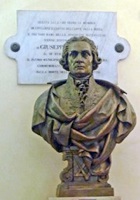
-
✴a huge portrait bust (illustrated here); and
-
✴models of his work, which include models of the interior and the exterior of the Teatro alla Scala, Milan.
The other rooms around the inner courtyard, along with four rooms on the floor below, form part of the Pinacoteca Civica.
Read more:
A. Dunlop, “Painted Palaces”, (2009) Pennsylvania contains two relevant sections:
“Room of the Arts and Planets, Foligno”, pp 73-87; and
“Palazzo Trinci and Inserted Histories”, pp 186-209
A. Caleca and B. Toscano (Eds), “Nuovi Studi sulla Pittura Tardogotica. Palazzo Trinci”, (2009) Foligno
G. Benazzi and F. Mancini (Eds), “Il Palazzo Trinci di Foligno”, (2001) Perugia contains the following particularly relevant articles for the frescoes by Gentile da Fabriano and his workshop:
C. Galassi, “Un Signore e il suo Palazzo: Iconografia, Cronologia e Committenza dei Cicli Pittorici nelle ‘Case Nuove’ di Ugolino Trinci”, pp 269-97
F. Mancini, “La Loggia delle Virtù: Allegoria di un Governo Illuminato”, pp 303-36
L. Lametti, “Il Manoscritto Intitolato ‘Appunti sopra la Città di Fuligno: Scritti da Lodovico Coltellini, Accademico Fulginio, Parte Nona, 1770-1780’”, pp 427-46
B. Gialluca, “Osservazioni sugli ‘Appunti sopra la Città di Fuligno: Scritti da Lodovico Coltellini, Accademico Fulginio, Parte Nona, 1770-1780’”, pp 447-57
G. Benazzi, “I Cicli Pittorici del Tempo di Ugolino e Corrado Trinci”, pp 459-94
In the same volume, later decoration is discussed in:
L. Teza, “La Decorazione di Palazzo Trinci nel XV e XVI Secolo”, pp 537-64
Proceed to the Chapel.
Return to Palazzo Trinci.



